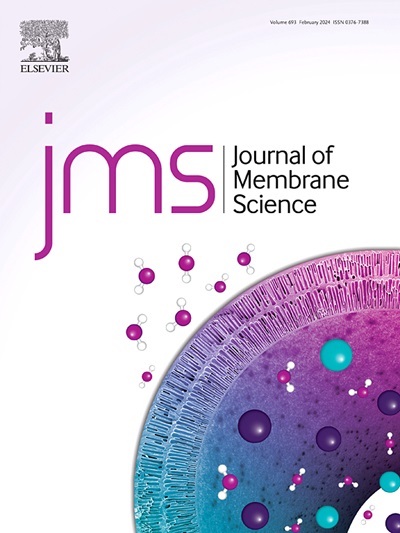Fabrication of asymmetric charge distribution mosaic membranes for ionic current rectification
IF 8.4
1区 工程技术
Q1 ENGINEERING, CHEMICAL
引用次数: 0
Abstract
The ion gating effect is crucial for numerous biological processes and provides valuable insights for the development of nanoscale artificial ion gates. Traditionally, ionic current rectification is achieved by designing asymmetric geometries or charge distributions via complex and cumulative procedures. Here, we report a simple aqueous immersion method for the fabrication of single-layer rectifying membranes. The prepared membrane exhibited a homogeneous distribution of positively and negatively charged groups in the interior and an asymmetric distribution of cationic and anionic groups on the two opposing surfaces, thereby enabling a satisfactory rectification effect for a variety of ions. These results indicate that the rectification ratio strongly correlates with the ion type and the ionic strength. The rectification ratios generally followed the order of Na3PO4 > Na3C6H5O7 > Na2SO4 > NaCl > KCl. Further analysis reveals that rectification efficiency is concentration-dependent. At lower concentrations (e.g., <100 mM), limited ion mobility reduces rectification performance, whereas higher concentrations (>100 mM) compress the electric double layer (EDL), diminishing charge selectivity. Optimal rectification is achieved at 100 mM ion concentration. This method provides a straightforward and viable solution for developing ion-selective membranes for ionic current rectification.
离子电流整流用不对称电荷分布镶嵌膜的制备
离子门效应对许多生物过程至关重要,为纳米级人工离子门的开发提供了有价值的见解。传统上,离子电流整流是通过复杂的累积过程设计不对称几何形状或电荷分布来实现的。在这里,我们报告了一种简单的水浸法制备单层整流膜的方法。所制备的膜在内部呈现出正电荷和负电荷的均匀分布,而在两个相对的表面呈现出阳离子和阴离子的不对称分布,从而能够对多种离子产生满意的整流效果。结果表明,精馏率与离子类型和离子强度密切相关。整流比一般为Na3PO4 >;Na3C6H5O7祝辞Na2SO4祝辞生理盐水比;氯化钾。进一步分析表明,精馏效率与浓度有关。在较低浓度(例如,>100 mM)下,有限的离子迁移率会降低整流性能,而较高浓度(>100 mM)会压缩双电层(EDL),从而降低电荷选择性。最佳的整流是在100毫米离子浓度。该方法为离子电流整流的离子选择膜的开发提供了一种简单可行的解决方案。
本文章由计算机程序翻译,如有差异,请以英文原文为准。
求助全文
约1分钟内获得全文
求助全文
来源期刊

Journal of Membrane Science
工程技术-高分子科学
CiteScore
17.10
自引率
17.90%
发文量
1031
审稿时长
2.5 months
期刊介绍:
The Journal of Membrane Science is a publication that focuses on membrane systems and is aimed at academic and industrial chemists, chemical engineers, materials scientists, and membranologists. It publishes original research and reviews on various aspects of membrane transport, membrane formation/structure, fouling, module/process design, and processes/applications. The journal primarily focuses on the structure, function, and performance of non-biological membranes but also includes papers that relate to biological membranes. The Journal of Membrane Science publishes Full Text Papers, State-of-the-Art Reviews, Letters to the Editor, and Perspectives.
 求助内容:
求助内容: 应助结果提醒方式:
应助结果提醒方式:


